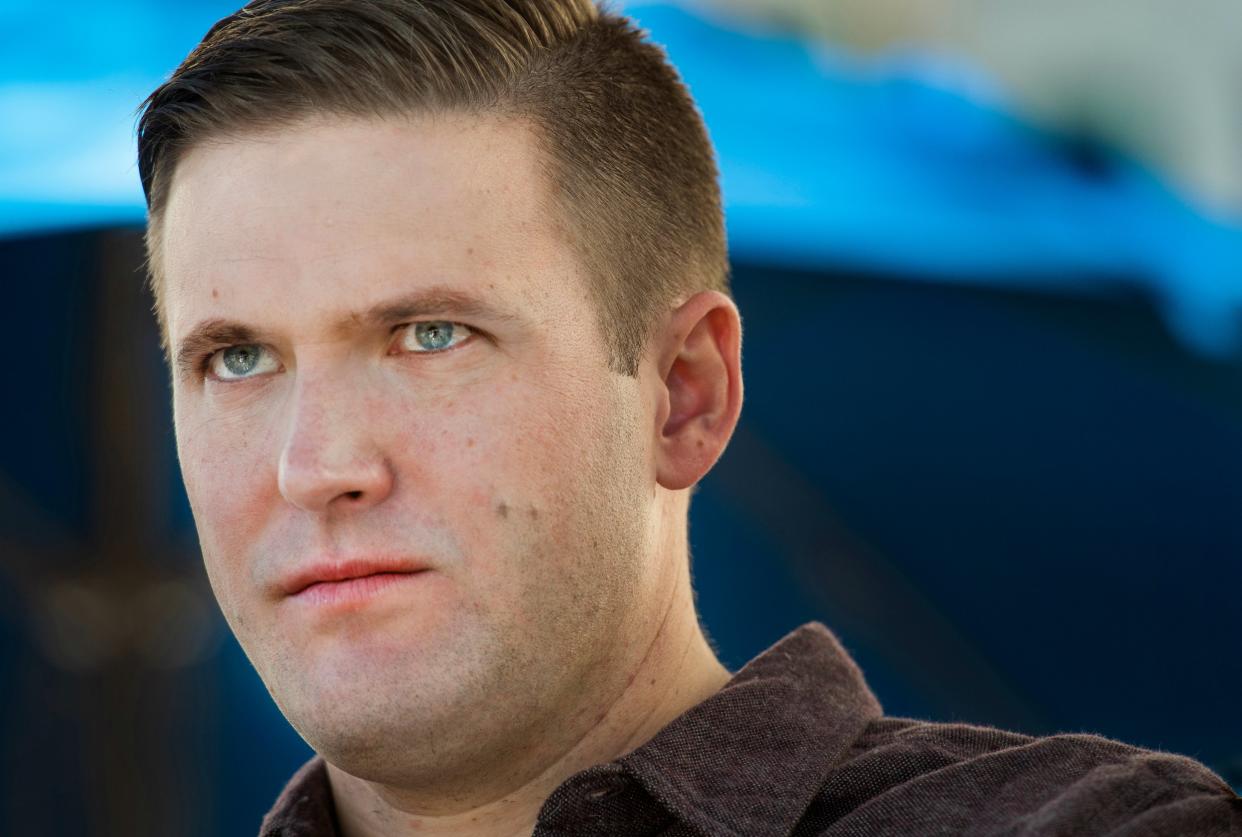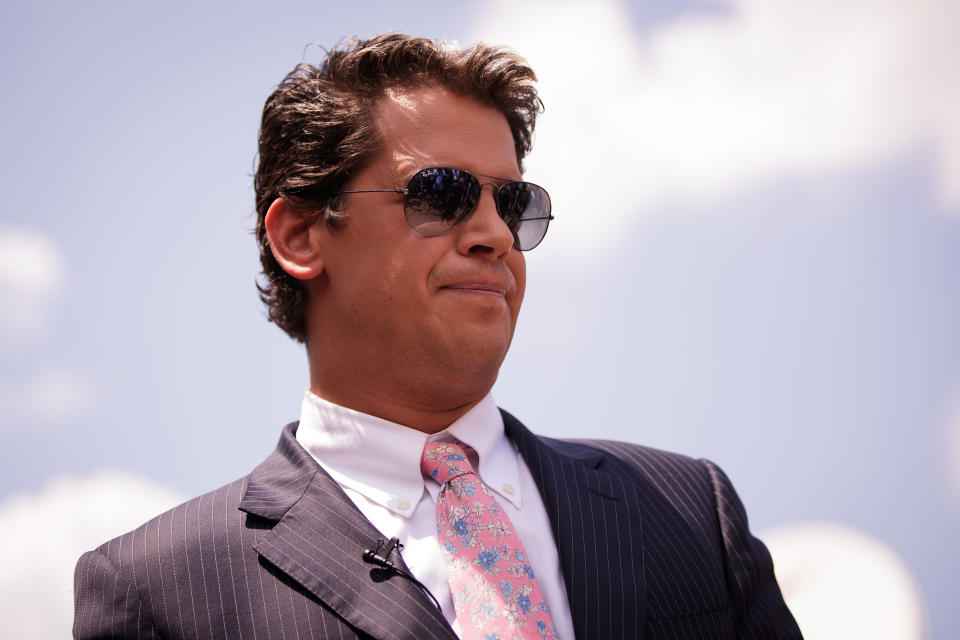What Is the "Alt-Right"?


The "alt-right" movement has surged into the spotlight this year, thanks to the candidacy of Donald Trump. Many of the adherents of the "alt-right" - white supremacists who, for the most part, want America or large swaths of it to be dominated by white people - have embraced President-elect Donald Trump, seeing him as sympathetic to their cause, if not an outright ally.
In November, the National Policy Institute, a group that advocates “white identity,” held a conference in Washington, D.C., where, at one point, its leader Richard Spencer said: “Hail Trump. Hail our people. Hail victory!” The room burst into applause as some people raised their hands in the Nazi salute.
So what, exactly, is the "alt-right," who are its members, and what has Donald Trump said about it? Here’s what you need to know.
1. The "alt-right" is a term invented in 2008.
Spencer - the guy who said, “Hail Trump. Hail our people. Hail victory!” - coined the term "alternative right," which became "alt-right," in 2008. According to the Southern Poverty Law Center, the term was meant to “describe a loose set of far-right ideals centered on ‘white identity’ and the preservation of ‘Western civilization.’”
In other words, the movement champions white people at the expense of people of color and immigrants. It is, according to the Associated Press, "a mix of racism, white nationalism, and old-fashioned populism."
The "alt-right" also broadly opposes the conservative establishment - they're against free trade and hold isolationist views on foreign policy - as well as traditional liberal values. Its "greatest points of unity," NPR explained, "lies in what they are against: multiculturalism, immigration, feminism and, above all, political correctness." The "alt-right" is also broadly anti-Semitic.
2. There’s no single platform or spokesman for the "alt-right."
In a manifesto about the "alt-right" published on Breitbart News, Allum Bokhari and Milo Yiannopoulos - who are both staff members at Breitbart - sought to define the term, but the "alt-right," according to Cas Mudde, a researcher at the Center for Research on Extremism at the University of Oslo, has no clear definition and no single leader. The number of people who consider themselves part of the "alt-right" is also unknown.
“The term ‘alt-right’ is nothing more than a clever marketing tool by a white supremacist activist, who knows that his ideology is considered unacceptable in today’s society," Mudde wrote in the Huffington Post. “Hence, he [Richard Spencer] came up with a term that sounds acceptable to the conservative mainstream.”
Mudde and others caution that one of the goals of the "alt-right" is to push its ideology into the mainstream by making it seem less threatening. "They've tried to broaden the definition so they can suck people into believing they’re alt-right, and then make themselves seem indispensable by saying, ‘Look at all these alt-right people,’” Ben Shapiro, a former Breitbart editor-at-large, told Slate.
In the wake of the U.S. election, news outlets including the New York Times, Washington Post, and NPR have reconsidered how they use the term "alt-right," according to the New York Times. The Associated Press, for instance, told its journalists they must define "alt-right" in their stories because “it is not well known and the term may exist primarily as a public relations device to make its supporters’ actual beliefs less clear and more acceptable to a broader audience.”
3. Yiannopoulos is considered the first "alt-right" celebrity.

Yiannopoulos, who is openly gay, is loved by the "alt-right," according to CBS News, which said his catchphrase is “feminism is cancer.” Yiannopoulos, CBS News added, "returns the affection" to the "alt-right." The manifesto he co-authored for Breitbart News sought to characterize the "alt-right" as more of an intellectual movement that also includes pranksters who don’t necessarily believe in white nationalism.
The National Review, a conservative magazine, published a forceful response to the piece. "Anyone familiar with Yiannopoulos’s theatrics ... will not be surprised to learn that the article is a 5,000-word whitewash," the National Review's Ian Tuttle wrote. "But it is valuable, in this way: It exhibits, albeit inadvertently, the moral and intellectual rot at the heart of the Alt-Right."
Yiannopoulos, who is the tech editor at Breitbart News, is an infamous Twitter troll who was barred from the platform for harassing Leslie Jones.
4. White nationalism is a big part of the "alt-right."
White nationalists are part of the "alt-right," but they're also a group unto themselves. For many people, "white nationalism" is just another term for "white supremacist" or "neo-Nazi," although CNN points out that white nationalists have tried to distance themselves from traditional hate groups like the Ku Klux Klan.
Eric Kaufmann, a professor of politics at Birkbeck University in London, told the New York Times that white nationalism is "the belief that national identity should be built around white ethnicity, and that white people should therefore maintain both a demographic majority and dominance of the nation's culture and public life."
Similar to white supremacy groups like the Ku Klux Klan, Kaufman continued, "white nationalism places the interests of white people over those of other racial groups." They think racial discrimination should be law. Spencer, the man who invented the term "alt-right," has, for instance, called for "peaceful ethnic cleansing," according to the Times, but he has not offered specifics on what, exactly, that means.
But the "alt-right" is more than just white nationalists. There is, for instance, a group within the "alt-right" that believe democracy is a failure and advocate for a monarchy. “Well, not monarchy specifically, but some kind of nondemocratic system with rule-driven succession,” according to Vox.com. This group calls itself "non-reactionaries."
There are also "identitarians," who, according to CNN, oppose multiculturalism and hold anti-Islamic attitudes. They emerged a decade ago in France.
And there are "radical traditionalists." They "want to preserve what they claim are traditional Christian values but from a uniquely white supremacist perspective," according to the Anti-Defamation League.
The movement’s core, however, is “white nationalism - or, at least, white identity politics,” according to George Hawley, a political scientist at the University of Alabama, who is writing a book about the "alt-right."
5. The "alt-right" consists mainly of young men, but there are some women.

The "alt-right" is made up mainly of white male Millennials with a college education, according to Hawley. There are some women involved with the "alt-right," Hawley told the Washington Post, but "this movement in particular is more appealing to men, particularly given the degree to which it is also a very outspoken anti-feminist movement."
6. Social media fueled the spread of the "alt-right."
The "alt-right" took root on the internet, as people who embrace these views shared their ideas on private message boards, 4chan, Reddit, and social networks like Twitter. Social media allowed members of the "alt-right" to remain anonymous - think of the internet’s anonymity as the modern version of the Ku Klux Klan hoods that hid the faces of its members. In November, Twitter suspended many of the high-profile accounts associated with the "alt-right."
7. Pepe the Frog is a mascot of the "alt-right."
When someone tries to insult my political ideologies pic.twitter.com/NvwRMLG84i
- Pepe The Frog (@rare_pepes) April 29, 2016
Pepe the Frog is a cartoon drawing used "by haters on social media to suggest racist, anti-Semitic or other bigoted notions," according to the Anti-Defamation League.
It is now listed as a hate symbol alongside burning crosses and swastikas.
The cartoon's creator, Matt Furie, who first drew it in 2005, never intended it to be a hate symbol, but the "alt-right" hijacked Pepe the Frog and created bigoted and anti-Semitic memes that it shared on sites like Reddit and 4chan.
Furie, who told Esquire.com in September that he planned to vote for Hillary Clinton, insists he has had nothing to do with the "alt-right's" appropriation of his cartoon.
Trump and his son, Donald Jr., have shared images with Pepe the Frog. Donald Jr. posted this image on Instagram:
And President-elect Trump retweeted this image in October 2015:
"@codyave: @drudgereport @BreitbartNews @Writeintrump "You Can't Stump the Trump" https://t.co/0xITB7XeJV pic.twitter.com/iF6S05se2w"
- Donald J. Trump (@realDonaldTrump) October 13, 2015
Both remain up on their respective accounts, although Donald Jr., later insisted in a Good Morning America interview that he has "never even heard of Pepe the Frog."
8. Donald Trump’s chief adviser has ties to the "alt-right."

Steven Bannon, the CEO of Trump’s campaign and now his chief adviser, was chairman of the website Breitbart News, which he once called “the platform for the alt right.”
While the site isn't as extreme as, say, The Daily Stormer, an "alt-right" website that refers to German Chancellor Angela Merkel as a "dog-faced liar" and has sections named the "Jewish Problem," it does publish stories that appeal to the "alt-right." Here are a handful Breitbart stories:
"World Health Organization Report: Trannies 49 Xs Higher HIV Rate"
"There's No Hiring Bias Against Women in Tech, They Just Suck at Interviews"
"Birth Control Makes Women Unattractive and Crazy"
"Read the Scary Descriptions of Refugees by Idaho Refugee Agency"
"Why White People Seek Black Privilege"
Breitbart also published and heavily promoted the "alt-right" manifesto by Bokhari and Yiannopoulos (that the site insists is nothing more than an explainer for conservatives).
George Hawley, the political science professor writing a book on the "alt-right," described Breitbart News as a “gateway drug to the harder stuff” associated with the alt-right and white nationalism.
By naming Bannon his chief adviser, Trump is seen as giving the "alt-right" a voice in the White House, and his appointment sparked protests across the nation.
But Bannon has recently sought to distance himself from the movement. In an interview with the Richmond Times-Dispatch published Nov. 26, Bannon said Trump must denounce hatred and racism. "I don't think it stands the test of logic, and there is no future for that, really, in America," he said of white nationalism.
9. Trump recently denounced the "alt-right."
Although Richard Spencer hailed the election of Trump, the president-elect has spoken out against the group. During a meeting with editors and reporters of the New York Times, Dean Baquet, executive editor of the Times, asked Trump about the "alt-right." Trump said: "I don't want to energize the group, and I disavow the group."
"It’s not a group I want to energize,” he added, “and if they are energized, I want to look into it and find out why.”
Trump also said he wouldn't have hired Bannon if he thought he was part of the "alt-right."
The Associated Press contributed to this report.
Follow Michael on Twitter.
You Might Also Like

